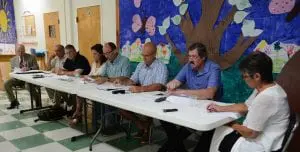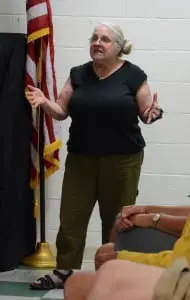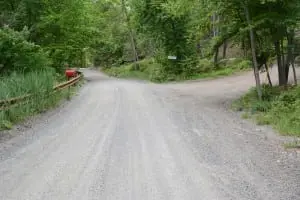Opponents allege ‘under the table’ acts and no ‘due diligence’
By Liz Schevtchuk Armstrong
Despite lengthy protests, irate dirt-road advocates Tuesday night (July 14) failed to deter the Philipstown Town Board from unanimously voting to pave a 2,600-foot strip of South Mountain Pass.
Citing a need to ensure environmental and human safety — including emergency-vehicle access — the board acted at a workshop capping seven weeks of intense public debate. Accompanied by children of assorted ages and at least one dog, approximately 50 residents filled the Recreation Center hall in Garrison for the board session. Over similar dissent, on June 10 the Town Board approved an expanded drainage project, to be complemented and protected by the paving, for the troublesome stretch of South Mountain Pass, leading uphill from Route 9D.
Twisting, with 10 to 15 percent grades, South Mountain Pass reportedly dates from colonial days and runs eastward from Route 9D to Route 9 just beyond the Putnam County–Philipstown border with Westchester County–Cortlandt.
Acrimony and allegations
Various audience members Tuesday raised the political “pork barrel” specter, cut into board members’ remarks and said, “You have to earn respect” to avoid such interruptions, alleged that Town Board actions stemmed from bribery and shouted angrily. Nearly all attendees denounced paving.
Christie Tomm Addona, an attorney for the Old Road Society, took the floor first. She handed Town Supervisor Richard Shea and Councilors John Van Tassel, Mike Leonard, Nancy Montgomery and Robert Flaherty a several-page letter that read like a court submission and concluded that “any vote on the paving proposal this evening would clearly violate SEQRA,” the New York State Environmental Quality Review Act.

Addressing the board, Addona outlined several perceived lapses, including failure to assess the ramifications of paving and supply documentation, such as a traffic study. “Primarily we believe it comes back to traffic,” she said. “A traffic study really has to be done.” And “the public really hasn’t had an opportunity to hear what this project is about,” she said.
Sandy Saunders stated that “we are blessed in this community with unique historical relevance,” reflected in such features as dirt roads. “Are we going to throw away history just for the hell of it? Or is there fake money on the table or under the table? We’re going to have to find that out, aren’t we?”
Shea remonstrated hotly. “What are you saying? You can’t make those kind of accusations.” He described Saunders’ allegation as a “reckless and inflammatory comment, speculating and asserting that the Town Board is [involved] in some sort of financial consideration because of this, that there’s under-the-table money. That’s outrageous and dangerous. It’s slanderous.”
When Saunders interrupted him, yelling, Shea added: “Your behavior is abhorrent.”
Andy Galler declared that the board should have taken the project to the Conservation Board, on which he serves, the New York State Department of Conservation and, probably, the Army Corps of Engineers. “I truly believe there was no due diligence done whatsoever,” he said.
Terry Zaleski, president of the Old Road Society, also criticized the process. “My sense is there was an early prejudgment made and it didn’t involve the community” or consideration of alternatives. Zaleski also faulted use of CHIPS funds and similar government allocations to cover the project’s cost — which Highway Superintendent Roger Chirico gave as $117,000. (CHIPS, 0r Consolidated Highway Improvement Program, funds are administered by New York State.) “This was pork barrel money,” he claimed.

But Shea called it “taxpayer money coming back to the community.”
Chirico said the town must “use it by December [or] we lose it” and that South Mountain Pass improvements had been anticipated since 2008, but delayed by hurricanes and other contingencies.
Nick Angell again proposed that the anti-paving delegation pay for a test of an alternate approach on a sample area of road and leave it for two to four months before evaluating it. “If it doesn’t work, you go forward” with the town’s methods, he said. “That’s our proposal. It’s professional and it takes the controversy out.” Overall, he said, “I think the Town Board has done a very good job” in governance “but you’ve stumbled here. There’s been a lack of disclosure and inaccurate disclosure.”
Glenn Lebwohl-Steiner expressed regrets “things have gotten to this point. I think you have worked very hard to include the input of people of this town,” but the South Mountain Pass actions “did not fit this track record,” she told the board. “We really need to pull together as a community. I don’t know what happened with the process here, but somehow people felt they were blindsided.”

“Please, please, please don’t do this [paving],” Alex Clifton pleaded. “We love it the way it is. This is the way of life we’re accustomed to.” Furthermore, “we are more interested in the day-to-day safety that comes from the fact people drive slower on dirt roads” than in possible emergencies, he said.
Theresa Orlandi and Joseph Flanagan own a home on 2.5 acres on Coppermine Road, which intersects the Pass.
Terming South Mountain Pass “a difficult and inconvenient place to live,” Orlandi said: “I totally get why something has to be done. However, I’m not convinced paving is the way to go. I don’t know if I’d sleep well at night if I had irrevocably changed the character of one of the main dirt roads in town.”
She also mentioned her children, who hike, bike and otherwise use the road for recreation. “Can you look me in the eye and tell me you believe they will be safe?” she asked the board. “We know if you pave parts of this road, people are going to drive too fast. The fact I haven’t been busted for speeding shows there’s zero enforcement” of traffic laws.
Flanagan maintained that “asphalt is a petrochemical. It’s going to get into the Hudson. It’s going to get onto the road, into the streams. It’s going to get into the estuary. It will get into groundwater wells.”
Shea objected: “There’s no science that says asphalt gets into people’s wells.”
Chirico reported that “dirt roads take chemicals 12 months a year; paved roads, only in winter.”
A minority view
A few attendees’ opinions differed. One woman said she found it “more than offensive” that allegations were hurled at those whose ideas clashed with the majority’s. “I think that takes away the whole democratic process,” she said. Her remarks generated loud boos from other attendees.
Ed Polhemus lives on South Mountain Pass. “I’m concerned about water running down the hill and getting onto my property,” he said. He observed notable development — houses and side roads — occurred along the Pass in the 20th century. Likewise, “I notice that there’s a few blacktop driveways on South Mountain Pass, so there’s got to be some other people that support blacktopping. I don’t know how we can say it’s a bad thing.”
A board rebuttal
One by one, the board members addressed the criticisms.
Shea said they had reviewed Angell’s alternative but were unwilling to risk an experiment that might fail and will delay paving until next year. Moreover, he continued, “we have an incredibly steep grade” on the stretch intended for paving. The town hauls dirt-road surfacing material from a distance, expending fuel, and “it winds up in the stream,” an environmental hazard, he said.
Montgomery said that all outside experts consulted talked “about the grade of this road and the need to pave it.” Flaws also exist in Angell’s alternative, she said. “If the purpose of the alternative is to preserve the aesthetic value of this road, throw it away because … we’d be better off paving.” Like Shea, she cited the ecological toll exacted by dirt-road treatments.

“I’ve sat at Copper Mine Creek. I’ve sat at the creeks off Old Albany Post Road. I sat at Indian Brook Road yesterday for an hour in the creek and watched and looked at the runoff,” she said. “I’m going to be taking a vote to preserve this dirt road, to pave the entrance to South Mountain Pass in order to preserve the rest of the dirt road; to preserve the quality of our streams that are really in jeopardy right now.”
“We have to look at it from an environmental perspective. The actions we’re taking here are better for the environment,” Leonard said. And “you have to make a decision for the entire town. The entire town is involved because we are clearly spending a lot. We can’t keep spending an exorbitant amount of money, constantly, for this road. What do we tell the rest of the town — ‘well, a majority of the people on this road want it [unpaved], so we’re spending a lot of your money to handle this’?”
“We represent 10,000” residents and must make the best decision for all, Van Tassel agreed. He mentioned the need for dirt-road emergency services access, recalling that “there were parts of this town completely cut off by Hurricane Irene.”
“Day-to-day safety!” an audience member shouted, suggesting it outranks emergency concerns.
Likewise, board members said they had weighed and sought anti-paving residents’ views.
“There has been an open and honest discussion, I think, from the get-go,” said Montgomery.
“We’re dealing with a problem that existed for a long, long time,” Flaherty added. In the board’s efforts to find a remedy, “I don’t feel anyone was blindsided at all.”
Shea noted the limited nature of the paving. “We’re not talking about an extended project here. We’re talking about one segment of road — not the entire Pass.”
After the vote, asked if paving opponents planned to sue the town, Zaleski responded: “We don’t know. We have to give consideration on how to proceed. They [the board] have not done their homework properly in advance of this decision.”
Photos by L.S. Armstrong


I did a survey on the ’72 Yammie 200 motorcycle tonight following up on a daytime swing. I counted six drains that were apparently raised via the brick and mortar job to bring them up to the anticipated asphalt level (work witnessed earlier). It turns out that the contractor neglected to install the drains at the proper level and the Town must use brick to raise them using materials and Town employee labor to finish. There are another 10 or so up the hill that are flush with the base dirt level. I would think they also have to be raised a similar brick’s width to be flush. Most of the fluorescent paint markings are gone.
I then took a cruise to the last Chrico pave job at the bottom of Albany Post Road where it meets with Sprout Brook. There there are curbs on each side which start at the top with a width at an estimated 18′. There is much better line of sight in that area and the road quickly widens to 25′ and 30′. The 10 drains are mostly flush with the pavement without much in the way of mini-curbs around them but there is one that is plumb flush level that has quite a bump to it. There are several on the SMP project that are also plumb level and stick out way more in the center of the road. Bust a plow anyone?
I then compared Winston Lane, Arden Road and Howland Drive and the Westchester section of South Mountain Pass. All of those roads are done without any curbing or drainage. There’s sections of Howland Drive which surpass South Mountain in grade. There is significant ‘alligatoring’ and crevasses on Howland. I’m guessing the job is at least a quarter century old.
So it seems to me that the drainage project sufficed as the ‘foot in the door’ to expedite paving. When Alex Clifton at the Town Recreation meeting was evincing a substantial majority opinion of residents against paving via old-fashioned gum shoe door knocking, Van Tassel interjects that the Board is representing the wishes and interests of the entire 10,000 person population of Philipstown, not those of a rowdy few on South Mountain Pass. Well, Mr. Van Tassel, why not hold this contentious issue up for a vote if you’re so confident?
Of the 100 or so who have attended the several meetings on this subject at least once, I would venture perhaps 10 favored paving and 90 opposed. Would the entire town go down as a pro-pave landslide in a referendum? I doubt it. Not if the facts were exposed.
As a resident of the lower Old Albany Post Road who opposed the partial paving, I’ve come to appreciate the efforts of the town to alleviate a constant problem of erosion and pollution the dirt road caused on this steep section. Not to mention, it’s a lot safer to ride my scooter on the paved road. If I had a horse and I was living back in the 1800s I probably would want it to remain dirt. I do like traveling on the portions of the historic dirt roads that are level and picturesque. Seems like a compromise can be struck if the town only considers the paving of steep trouble spots.
South Mountain Pass will become like the Palisades Parkway was last winter, full of potholes. Is this really an improvement, or just another problem being laid down? I am curious to see how the spring thaw is handled by the asphalt. What will washboard look like in asphalt? How long will it take for serious deterioration of the asphalt? Do we go back to dirt if it fails within two to three years?
Am I the first to “tell justice that there has been a death in the family”? While I am unfortunately not surprised that we (meaning that the residents of South Mountain Pass and other plaintiffs of notice) lost the Article 78 challenge to the paving of said road, I have two major issues. Judge Victor Grossman, whether he likes to admit this or not, is conflicted on two significant prongs. First, one of the plaintiffs in the aforementioned suit was a client of his; second, he is one of the few Democrats in the only Downstate county who is Republican. Where are Judge Grossman’s priorities; protecting his party? Furthermore, if one looks at his credentials, one needs to wonder why in this great nation of ours that we elect justices rather than hire or appoint them on their expertise. From what I can ascertain, Judge Grossman is not in a position to decide on such matter. Shame on you, Judge Grossman.